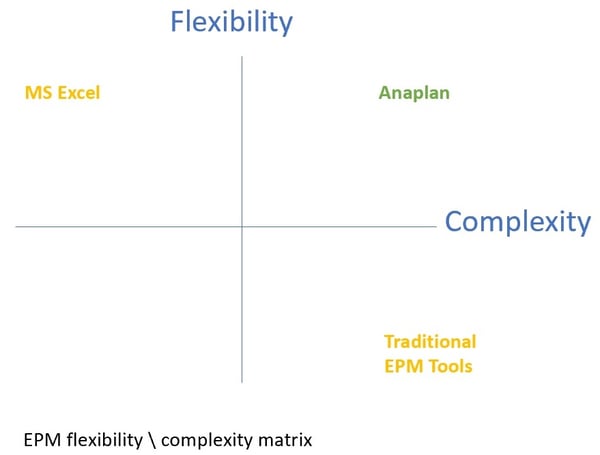The static business plans of yesterday are no longer equipped to respond to the dynamic market conditions of today. That’s where Connected Planning comes in. It’s the journey of unifying business processes across your entire organisation while allowing you to accelerate business value by breaking down information silos and eliminating inefficiencies.

Created by Anaplan, Connected Planning allows people, data and plans to interact directly so you can better manage planning processes at every level. Continue reading to find out more about Connected Planning in greater detail, its purpose and 12 benefits of adopting this planning method.
- What is Connected Planning...In More Detail
- What is the Purpose of Connected Planning?
- The Benefits of Connected Planning
What is Connected Planning...In More Detail
Many businesses today are regularly facing the excruciating and exhausting challenge of having people, data and plans all operated from isolated spreadsheets. The biggest issue is that cross-enterprise collaboration is neither effective nor possible.
Connected Planning enables the collaboration, insights and predictive, self-learning capabilities necessary to inform strategic decision-making. As planning processes, people and data are inextricably linked on a Connected Planning platform like Anaplan. In fact With Connected Planning, the more you connect - the greater the value.
Using Anaplan it’s possible, as plans are adapted, to see the impact across affected business unit plans in real-time. This means that key decisions can be taken quickly, with full knowledge of the consequences for the business.
This also highlights the flexibility vs complexity issue. Spreadsheets create silos of data which are infinitely flexible within a single workbook. This comes at a price however, as spreadsheets don’t handle complexity very well, they are prone to error and difficult to unravel when questions are raised.
 Plus, with a spreadsheet, collaboration is a challenge! Even when it sits on a shared drive the model is “locked” whilst one contributor is updating; it is very difficult to prevent unauthorised modification of the underlying model; and process steps such as email requests for updates and approvals are difficult to integrate. Spreadsheets are fundamentally single user, desk-top tools whereas enterprise planning, budgeting and forecasting needs multiple, concurrent user, modelling capabilities. As a result spreadsheets-based planning processes are massively more time-consuming and laborious to manage.
Plus, with a spreadsheet, collaboration is a challenge! Even when it sits on a shared drive the model is “locked” whilst one contributor is updating; it is very difficult to prevent unauthorised modification of the underlying model; and process steps such as email requests for updates and approvals are difficult to integrate. Spreadsheets are fundamentally single user, desk-top tools whereas enterprise planning, budgeting and forecasting needs multiple, concurrent user, modelling capabilities. As a result spreadsheets-based planning processes are massively more time-consuming and laborious to manage.
Connected Planning, on the other hand, is designed to give you the best of both worlds by managing complex models that can be flexed by concurrent users in real-time to reflect changes in your business environment. Connected Planning grows with you and your business so that leaders in your organisation can make challenging decisions quickly and confidently. The power of planning should be in the hands of every individual within your organisation so that the strongest people use the best available data to make better-informed decisions.
With Connected Planning implemented in your organisation, you can leverage the combined power of people and planning technology to make the most of the natural connections that already exist in your organisation.
What is the Purpose of Connected Planning?
The purpose of Anaplan’s Connected Planning solution is to have one reliable source of information, that is, 'one version of the truth'. It’s so that each role within your organisation has the correct views of what’s happening in their business unit and the impact on them of changes coming from other areas of the business.
The Benefits of Connected Planning
In the modern world, organisations need speed, productivity and foresight in order to maintain timely and relevant plans. Speed allows you to plan and pivot faster than your competition; productivity enables your high-value workers to spend less time manipulating data to do actual high-value work; foresight provides accurate forward-looking information to help leaders make more impactful decisions.
This is exactly what Connected Planning provides.
Here are some of the many benefits that organisations can take advantage of when Connected Planning has been implemented successfully.
Finally Achieve a Single Source of Truth
This is the phrase most commonly referenced by Anaplan when describing Connected Planning. Any organisation that struggles with data and planning silos will benefit from this. Sales, HR, Supply Chain and practically every other function are typically making forecasts independently.
The problem? The numbers don’t always match. Many are locked in spreadsheets that don’t get shared. Connected Planning pulls all of the relevant data together - even from the ubiquitous spreadsheets - in one place and helps you build models using as single data set connected across business units.
Use Data to Make More Informed Decisions
Connected Planning allows users to leverage more data in a variety of formats for more detailed or nuanced modelling scenarios. It’s transforming the way enterprises like yours are working - allowing for more informed decisions based on data accumulated from every corner of the organisation.
This doesn’t just allow real-time coordination. It also aggregates an ever-growing volume of data which create detailed simulations that qualify the assumptions of leaders in your organisation.
Modify Plans Easier
Connected Planning allows you to modify plans 'on-the-go' and identify the real drivers of business performance. This is because the impact of any adjustments are seen automatically across the affected plans.
Following a change, a version of the plan can be saved. It is easy to do a retrospective review to establish why performance differed from the plan. The soul-destroying and counterproductive effort caused by regular backtracking through disconnected departments and spreadsheets is avoided.
Define Your Future Performance
More often than not, teams waste a vast amount of their time during planning cycles relying on historic data to predict future performance. This is an extremely inefficient process as what happened in the past isn’t a reliable predictor of future performance.
With Connected Planning, organisations can shift their focus from data consolidation to analysing and determining risks and opportunities to ensure the best possible outcomes.
The Time Between Planning and Real-Time Decision-Making Becomes Zero
CFOs tell us that running scenarios is the key business requirement. In other words, they need the ability to assess alternative responses to market changes quickly. Fast scenario planning means that new plans can be tested “on-the-fly”.
Cope with Rapid Change
The ability to assess alternative responses to market changes is key, so fast scenario planning means that new plans can be tested on-the-fly.
Business conditions change rapidly. Industries change overnight. Rapid change is inevitable, and organisations need a planning platform that can cope with this. Anaplan’s Connected Planning solution is uniquely positioned to respond to all business change and help drive your organisation forward during even the most volatile and uncertain times.
Make Immediate Adjustments
Feedback is vital when it comes to making successful adjustments. When every planning activity is executed within a single platform that leverages shared data, such as Anaplan, getting the relevant people to trust the plans becomes simpler.
This also then generates speed in the decision-making cycle. Groups can also collaborate in real-time so that immediate adjustments can be implemented in your organisation - taking into account feedback from across the organisation.
Make Necessary Changes at a Rapid Rate
Connected Planning enhances corporate collaboration, dynamism and intelligence. Your organisation can finally make changes as the world changes or, in some cases, even faster. For example, Sonos - now execute demand changes in one day, compared with two weeks prior to Connected Planning.
It works even better when you combine that with data and predictive technology. Predictive scenario modelling allows you to test alternative plans or actions using scenario planning to arrive at the most optimum solution.
This is possible because the latest technology like Anaplan can recalculate vast amounts of data very quickly. By being able to answer what-if questions, it enables you to evaluate strategic options, test alternative responses to changes in the environment and much more. To explore further about predictive technology, read our blog post about AI planning.
Handle Complexity
Operational processes can be complex. Unlike traditional planning applications which can force you to model around a software’s limited capabilities, your organisation needs a platform that can model even the most complex business models. This allows you to process large amounts of data in real-time to deliver new plans - fast. One of our clients, a Healthcare product manufacturer, has a seven-step production process involving 3 manufacturing sites, transportation of sub-assemblies and storage of the finished product in each market. In real time they can see the impact of changes in supply chain volumes, unit rates and process times on the availability of finished product.
Scale Beyond Today’s Challenges
Your organisation could be one that operates globally, employs many people and produces a lot of data that needs to be analysed.
Or, like our manufacturer above, you might be in product launch mode. Anaplan’s flexibility and speed of modelling means that your model can be adapted quickly to new requirements as you grow. With a cloud platform you can increase your storage and calculation capability when you need it. In short Anaplan is built to scale with your business growth.
Drive A Culture of Connectedness
Culture is critical when you begin your Connected Planning journey. With traditional means of planning, finance teams spent a lot of time working with data in planning and re-forecasting processes.
Anaplan’s Connected Planning platform is capable of modelling actual results alongside future predictions, such as seasonal trends, connecting to external predicted weather patterns for example. Anaplan helps you make decisions easier and helps model future projections with greater confidence and accuracy.
Connected Planning removes non-value added work and enables finance change, for instance, taking on the role of business advisor or finance business partner. Trust in business data and collaboration helps to forge a strong partnership between finance and the rest of the business. As Heather Williams, Senior Director of Integrated Business Planning at Sonos said: ‘’Our ability to collaborate internally is vastly improved, which reduces the stress level and really enables a better team relationship’’.
Now that you know all about Connected Planning, its benefits and purpose, it’s the perfect time to learn more about this solution.
GET YOUR ALL-IN-ONE GUIDE TO CONNECTED PLANNING
The aim of every organisation is to become agile and responsive so that you can quickly react to shifting consumer demands. Anaplan has created Connected Planning to make this process easier - and we’ve produced an all-in-one whitepaper for everything you need to know about switching to Connected Planning.







